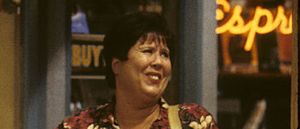This week, the Center for Disease Control and Prevention expanded its recommendation for masks, saying that everyone should wear them when they go out if possible. The news confused some people, as experts have previously said that masks should be left for the medical professionals who need them most. However, for civilians, the CDC is actually recommending homemade cloth masks, and there are a few ways to make your own.
President Donald Trump announced that the CDC was extending its face mask recommendation to the general public in a press conference on Friday. He stressed that the measure was voluntary, saying that he himself would not be wearing one. The CDC posted a detailed explanation online later, specifying that surgical masks and N95 masks should still be left for medical professionals only. The average person, however, might benefit from a cloth face covering of some kind.
Videos by PopCulture.com
“We now know from recent studies that a significant portion of individuals with coronavirus lack symptoms (‘asymptomatic’) and that even those who eventually develop symptoms (‘pre-symptomatic’) can transmit the virus to others before showing symptoms,” the center explained. “This means that the virus can spread between people interacting in close proximity — for example, speaking, coughing, or sneezing — even if those people are not exhibiting symptoms. In light of this new evidence, CDC recommends wearing cloth face coverings in public settings where other social distancing measures are difficult to maintain (e.g., grocery stores and pharmacies) especially in areas of significant community-based transmission.”
The CDC emphasized that the absolute best option for preventing the spread of coronavirus is still social distancing — staying home as much as possible and maintaining at least 6 feet of distance between yourself and other people. For essential trips to the grocery store or pharmacy, however, a face mask may be helpful.
Here are some of the most popular ways of covering your face for unavoidable trips.
Cloth Mask
One of the most popular methods going around can be made simply with a bandana or similarly sized piece of cloth, and two rubber bands or hair ties. As Surgeon General Dr. Jerome Adams demonstrates, the cloth simply needs to be folded to the right size, with rubber bands at each end to go over your ears. This mimics the look and application of a plain surgical mask.
Extras
Fold in 1/2 & then in thirds; slip hairband over each end. Fold ends in (adjust); hairband over ears pic.twitter.com/DY6uCxcg56
— Zoje Stage (@zooshka) April 3, 2020
For added comfort and effectiveness, many people are using hair ties instead of rubber hands. Some are also pinning the cloth on the last fold to ensure that it stays in place. The masks may not be sturdy enough for an operating room, but this way they will be comfortable enough to wear for a grocery shopping trip.
Fashion Statements
I have shared before, these masks are handmade items made by me
— 𝓟𝓮𝓻𝓽𝓱𝓹𝓹𝓮 (@SmileOfyou_1912) April 4, 2020
The reality is for personal use and family members but a lot of my friends want a unique mask so I sell it online as well as support for those who need it💕
So good idea, right? We’ll win Covid#KDPPEmarket#KDPPE pic.twitter.com/lexPEdbsBR
Some people with sewing and embroidering skills have taken to making more intricate masks, and some are quickly becoming hot ticket items. For a bit of flare in your protective gear, take a look at social media or crafting sites like Etsy for a mask that makes a statement. By buying one, you may support someone who is out of work due to the pandemic as well.
Washing
Heading out for groceries with my old 2003 Hong Kong SARS mask cover on. It’s not protective, for me, but it keeps any viruses I might be hosting from spreading to others.#NYC #COVID19 pic.twitter.com/SlJwdxn7eQ
— Laurie Garrett (@Laurie_Garrett) April 4, 2020
In an interview with NPR, Columbia University’s Dr. Daniel Griffin said that cloth face masks should be treated “like underwear” and washed after each use.
“You don’t take this dirty mask off, put it in your purse and then stick it back on your face,” he says. “It’s something that once you put on, is potentially either touching your coughs, sneezes or the spray of your speech, or protecting you from the coughs, spray, speech of other people. And now it’s dirty. It needs to basically be either discarded or washed.”
Scarves, Bandanas and Other Alternatives
It’s time for the scarf mask – pic.twitter.com/uThnZBwUuj
— 🌈Dáire🦄📸🤓 (@daire_shaw) April 4, 2020
Of course, many people are hoping that an existing scarf, buff or ski mask they already have can be used in place of a homemade mask. Experts say the impact of these may vary, and there is not enough research to be sure. However, Dr. Michael Klompas of Brigham and Women’s Hospital in Boston told NPR that the tighter-fitting a face covering is, the more effect it is likely to have.
“You can imagine if you put a loosely knit scarf with lots of holes in it… that would not be very effective,” he said.
Donations
reversible 100% cotton masks made by Mom, a quilter #maskupPA pic.twitter.com/suLgOgFlNy
— C Weaver (@weidence) April 4, 2020
We are so proud of BMS 7th grader Sloane Conway who normally makes hats and scarves but has transitioned to making masks and giving them to the local hospitals! #BMSspirit pic.twitter.com/h7g0DV1JYF
— Brentwood Middle (@wcsBMS) April 3, 2020
Many people finding themselves out of work due to the coronavirus are looking for ways to keep busy and to help, and donating masks can be a great way to do so. Some hospitals or treatment centers, such as Johns Hopkins University, are accepting donated cloth masks for non-patient care settings. They are reportedly asking that the masks not be made in solid colors like blue or white, as they might be confused with medical grade masks. Beyond that, the efforts of those with sewing skills are greatly appreciated by medical first responders.
Risks
Approximately half the people at the grocery store today wore masks. Mine is home made from a ski scarf. #COVID19 pic.twitter.com/HJ9Y4cYsWy
— bernieborges (@bernieborges) April 4, 2020
It is worth noting that homemade masks are uncharted territory in many cases. One study in Vietnam found that the use of cloth masks resulted in greater infection than those wearing surgical masks. Experts believe that the cloth coverings are better than nothing, especially for the short-term purposes of a trip to the pharmacy, but stress that there is not enough data yet to be conclusive.
To get the most out of your homemade mask, experts say you should not touch it once it is in place, wash it after each use and avoid going out as much as possible.
Ongoing Confusion
You don’t need to wear a mask. Wear a mask. Masks are only important if you are infected. So don’t wear them. But you should wear them because you might be asymptomatic. But don’t buy surgical masks or respirators. Just use some kind of cloth. But you don’t need them. What?!
— 🇺🇸Lionel🇺🇸 (@LionelMedia) April 4, 2020
Finally, the change of policy on masks has some people confused and uncertain. On social media, many are wondering what other changes might be coming. As always, social distancing remains the most important and most effective measure to prevent the spread of the coronavirus.
Visit the CDC’s website for the latest information on the COVID-19 pandemic.








